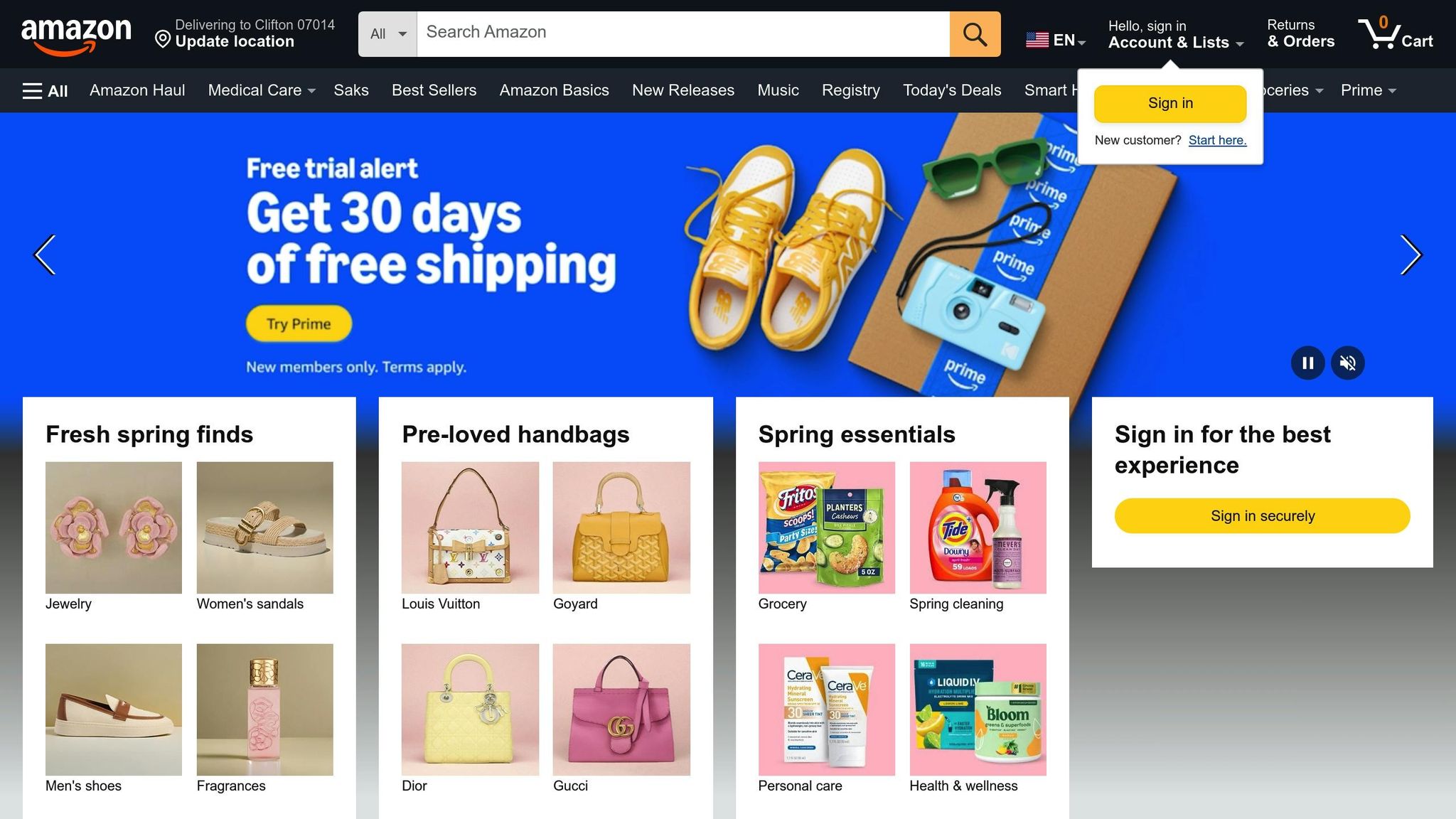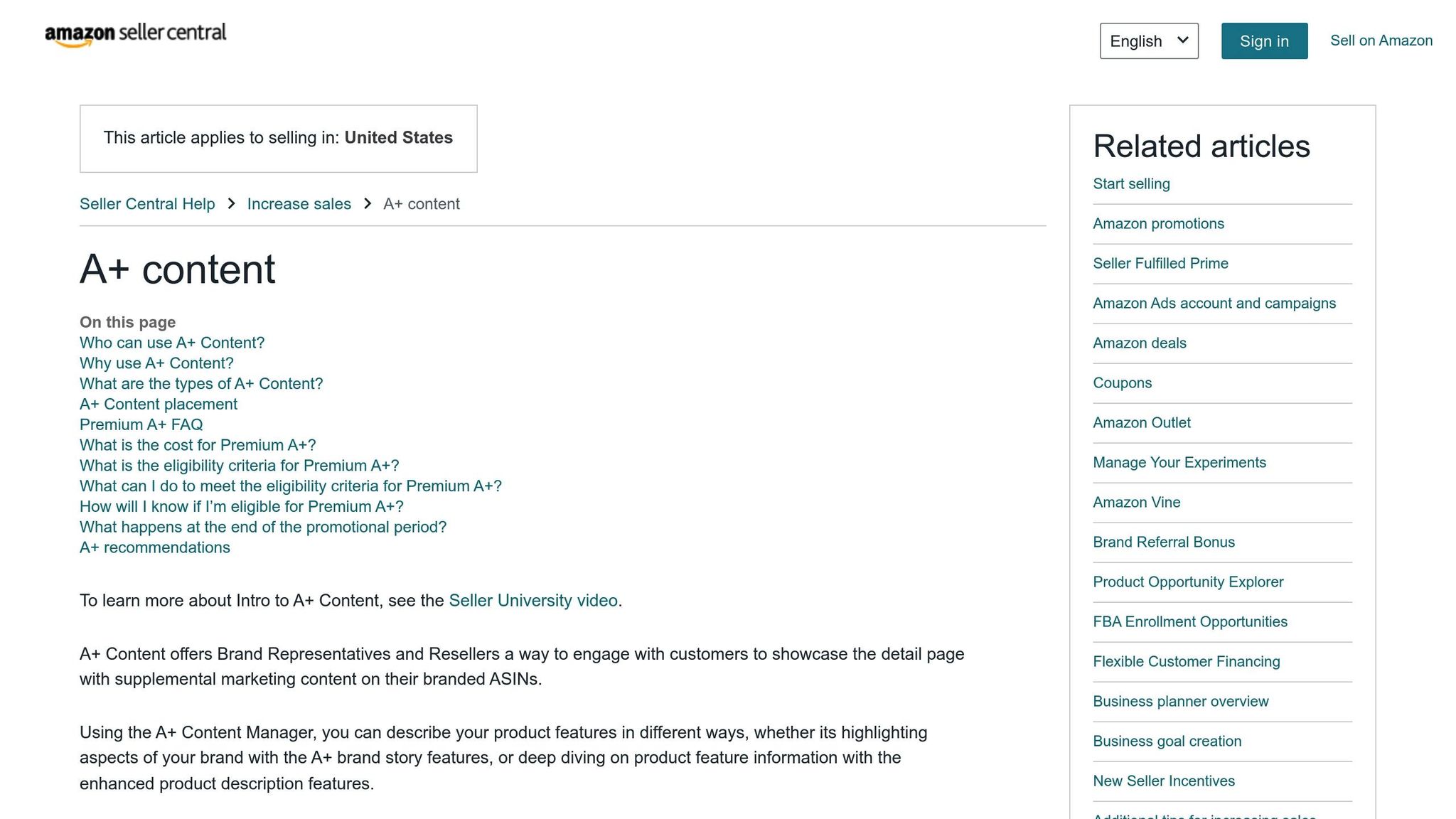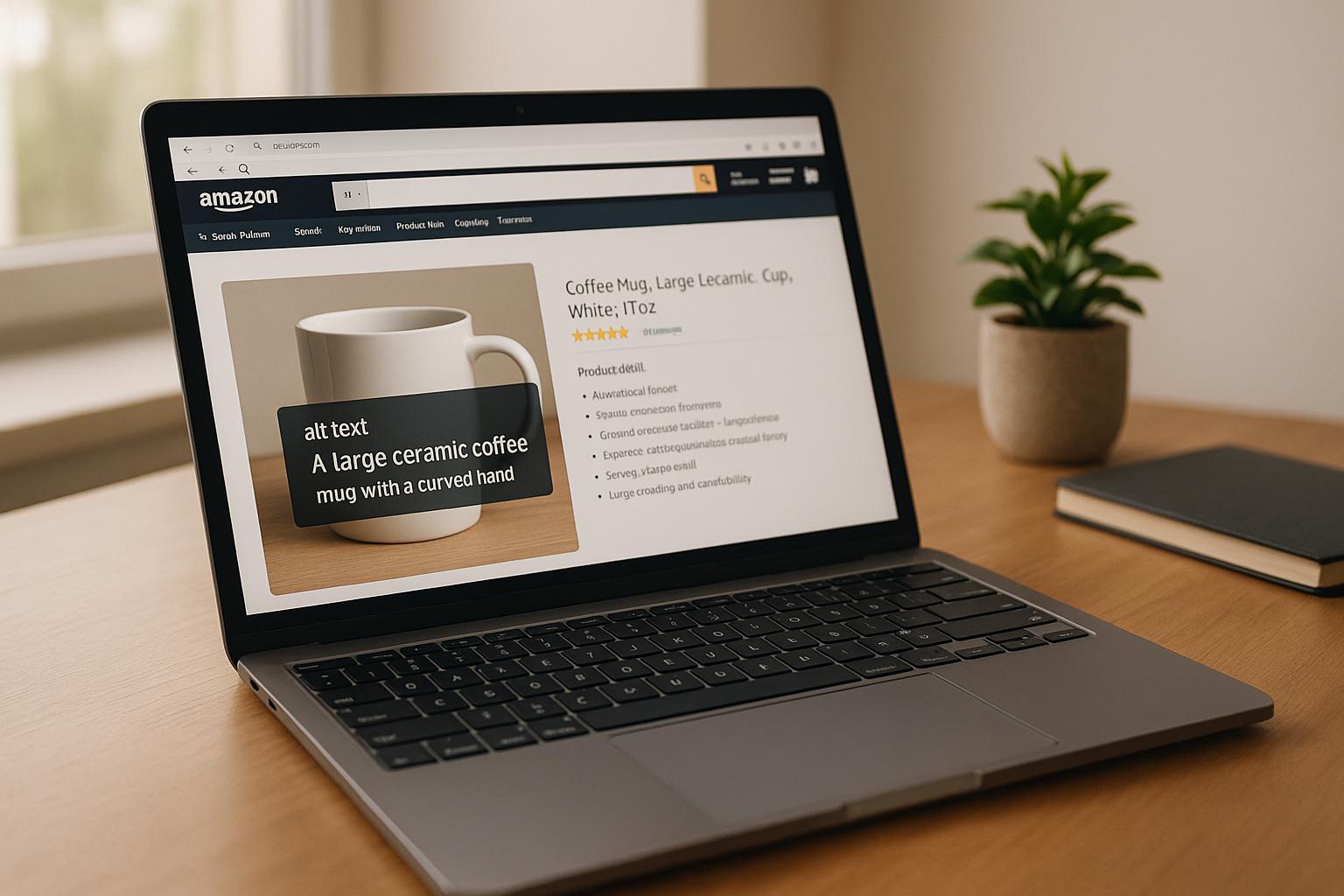Want to boost your Amazon product rankings? Start with optimized alt text. Alt text describes your product images, helping Amazon’s search engine understand and rank your listings better. It also makes your products accessible to visually impaired users.
Key Takeaways:
- What is Alt Text?: A concise description of your product image, like "Men’s Navy Blue Cotton Shirt with Chest Pocket."
- Why It Matters: Improves search visibility, supports accessibility, and helps users when images fail to load.
- Best Practices:
- Use 50-250 characters.
- Include relevant keywords naturally.
- Write unique descriptions for each image.
- Avoid pricing, promotions, or irrelevant details.
- How to Add It: Use Amazon’s A+ Content Manager to update alt text under the "Image Keywords" section.
Tip: Focus on clear, keyword-rich descriptions that highlight your product’s features. Regularly review and update alt text to stay competitive.
Learn how to write effective alt text and improve your Amazon SEO below.
The RIGHT Way to Use Amazon Image Keywords (Alt Text)

Adding Alt Text to Amazon Products
Alt text can give your Amazon listings a boost in search visibility. Here’s how to include it effectively.
Using A+ Content Manager

You can add alt text directly through Amazon Seller Central‘s A+ Content Manager by following these steps:
- Go to the A+ Content Manager in Seller Central.
- Select the ASIN or product you want to update.
- Locate the "Image Keywords" section under each product image.
- Click the edit option to add or update the alt text.
Make sure each image has its own unique, keyword-focused alt text.
Guidelines for Amazon Alt Text
Amazon has specific rules for alt text. Here’s what you need to know:
- Keep it between 50-250 characters per image.
- Use proper grammar and punctuation.
- Avoid promotional language or pricing details.
- Focus on relevant product features.
- Be accurate and descriptive.
| Alt Text Rule | Example of Proper Alt Text |
|---|---|
| Descriptive Details | "Women’s Red Leather Crossbody Bag with Gold Hardware and Adjustable Strap" |
| Technical Specifications | "15.6-inch Gaming Laptop with RGB Keyboard and 144Hz Display" |
| Material Information | "Solid Oak Dining Table with Natural Finish and Black Metal Legs" |
Writing Strong Alt Text
Creating effective alt text for Amazon product images means striking the right balance between SEO optimization and clear, descriptive content. Here’s how to write alt text that boosts visibility while staying within Amazon’s guidelines.
Clear and Descriptive Text with Keywords
Good alt text combines relevant keywords with clear descriptions. Focus on showcasing the product’s key features and details. Here’s a comparison:
| Product Type | Poor Alt Text | Strong Alt Text |
|---|---|---|
| Kitchen Appliance | "Red blender" | "Professional 1000W Countertop Blender with 72oz Glass Pitcher for Smoothies" |
| Clothing | "Blue dress women" | "Women’s Navy A-Line Midi Dress with Pockets and Quarter-Length Sleeves" |
| Electronics | "Wireless headphones" | "Over-Ear Bluetooth Headphones with Active Noise Cancellation and 30-Hour Battery" |
Amazon Alt Text Guidelines
Amazon has specific rules for alt text to ensure descriptions are helpful and compliant. Key points to remember:
- Character count: Use between 50 and 250 characters.
- Grammar: Write in complete sentences with proper punctuation.
- Unique text: Each image needs its own alt text.
- Avoid restricted content: Don’t include prices, promotional language, or seller details.
- Accuracy: Make sure the description matches the image exactly.
Tip: Put the most important product details at the beginning of your alt text. Amazon’s algorithm tends to prioritize early words in descriptions.
Placing Keywords Effectively
Placing keywords thoughtfully can improve your product’s search rankings. Here’s how:
- Start with the primary keyword
Lead with your main keyword naturally to help Amazon identify the image’s focus. For instance, "Over-Ear Bluetooth Headphones" works better than burying the keyword mid-sentence. - Use secondary keywords smoothly
Add secondary keywords in a way that feels natural. Instead of writing "coffee maker programmable automatic drip", try "Programmable 12-Cup Automatic Drip Coffee Maker with Built-in Water Filter." - Mention variations when relevant
Include common variations or uses, but avoid overloading the text. For example: "Adjustable Standing Desk for Home Office or Gaming Setup with Electric Height Control."
Pro Tip: After updating your alt text, track your product’s search performance for a few weeks. Use this data to tweak your descriptions gradually rather than making sweeping changes all at once. This lets you refine your strategy based on real results.
sbb-itb-880d5b6
Alt Text for Multiple Product Images
Why Covering All Images Matters
Writing alt text for every image boosts your product’s visibility in search results. Each image gives you a fresh opportunity to target relevant keywords while showcasing your product’s features.
Here’s how a complete alt text approach can help:
- Better search visibility: Optimized alt text for each image helps Amazon’s search algorithm understand and index your product more effectively.
- Showcase different features: You can target various keywords and highlight unique aspects of your product with each image.
- Support accessibility: Descriptive alt text improves the shopping experience for visually impaired users, which can lead to higher conversions.
Now, let’s break down how to create effective alt text for different types of images.
Key Elements of Effective Alt Text
Each alt text should be distinct but follow a consistent style. Below is a guide to structuring alt text based on image type:
| Image Type | Alt Text Focus | Example Structure |
|---|---|---|
| Main Product Shot | Key features and main keywords | "Professional 48-inch Standing Desk with Dual Motors and Memory Settings" |
| Detail Views | Specific components and materials | "Steel Frame Construction with Cable Management System and Anti-Collision Technology" |
| Lifestyle Images | Use cases and settings | "Home Office Standing Desk Setup with Dual Monitor Mount and Ergonomic Design" |
| Size/Scale Images | Dimensions and comparisons | "Standing Desk with 48×30-inch Desktop Surface Supporting up to 350 pounds" |
- Avoid repetition: Use different keywords and phrases for each image’s alt text.
- Stay relevant: Make sure the description accurately matches what’s shown in the image.
- Maintain consistency: Use a uniform style while tailoring the content to each image.
Tip: Start by optimizing the alt text for your main product image since it usually has the most influence on Amazon’s search algorithm. Then, focus on secondary images in order of their importance to your listing’s success.
Alt Text Management
When to Update Alt Text
Keeping your alt text up-to-date is crucial for maintaining strong search performance. Here’s when you should consider making updates:
Product Updates
- When introducing new product variations or features
- After changes to product specifications
- Following packaging updates
- For seasonal product variations
Performance Reviews
- During monthly search ranking evaluations
- After quarterly click-through rate analyses
- If there are noticeable shifts in traffic or conversions
External Influences
- When Amazon updates its policies
- As industry-specific terms evolve
- For seasonal events or promotions
- If competitors start ranking higher
Using the right tools can make these updates more efficient and effective.
Tools for Alt Text Optimization
SEO tools can simplify the process of managing alt text. For example, SearchX‘s Amazon SEO services offer features like:
Keyword Research Tools
- Insights into real-time trends
- Search volume analysis
- Identification of competitor gaps
- Suggestions for category-specific keywords
| Alt Text Review Task | How Often to Check | What to Focus On |
|---|---|---|
| Keyword Performance Check | Monthly | Trends in search volume, click-through rates |
| Content Relevance Audit | Quarterly | Product updates, seasonal adjustments |
| Compliance Review | Bi-annually | Amazon policy changes, industry standards |
| Competition Analysis | Monthly | Competitor rankings, market positioning |
Tips for Managing Alt Text Effectively
- Set up a consistent review schedule
- Keep a record of changes and their impact
- Maintain updated lists of category-specific keywords
- Stay informed about Amazon algorithm updates
Conclusion
Effective alt text optimization strikes the right balance between improving SEO and ensuring accessibility. By following best practices, sellers can boost product visibility while keeping their listings accessible to all users.
Alt Text Best Practices Summary
Key Guidelines for Implementation
Alt text optimization hinges on three main principles:
- Clear and Descriptive Text
Use concise descriptions that accurately reflect the product image. Include relevant keywords naturally without sacrificing readability. For instance, instead of "blue shirt", opt for something like "Men’s Wrinkle-Resistant Oxford Shirt with Pearl Buttons." - Adherence to Technical Standards
Stick to Amazon’s alt text guidelines to improve both search rankings and user experience. Meeting these standards ensures your images contribute effectively to visibility and usability. - Regular Updates
SEO evolves over time, so it’s important to revisit and refine your alt text periodically. This keeps your descriptions aligned with current search trends and any changes in product details.
FAQs
How does optimizing alt text help improve the visibility of my Amazon product listings?
Optimizing alt text for your Amazon product images can significantly enhance their search visibility. Alt text, or alternative text, is a brief description of an image that helps search engines understand its content. When crafted effectively, it can improve your product’s chances of appearing in relevant search results, both on Amazon and external search engines like Google.
To make the most of alt text, focus on these best practices:
- Be descriptive and specific: Clearly describe the product and its key features.
- Incorporate keywords naturally: Use relevant keywords, but avoid keyword stuffing.
- Keep it concise: Write short, meaningful descriptions that are easy to understand.
By following these steps, you can increase the likelihood of your products being discovered by potential customers, ultimately driving more traffic and sales.
What mistakes should I avoid when writing alt text for Amazon product images?
When writing alt text for Amazon product images, avoid these common mistakes:
- Overloading with keywords: Stuffing keywords into alt text can make it look spammy and harm your SEO instead of helping it.
- Using generic descriptions: Avoid vague terms like "image" or "photo." Be specific and describe the product clearly.
- Ignoring accessibility: Alt text is not just for SEO; it also helps visually impaired users. Ensure your descriptions are meaningful and accurate.
- Including non-relevant information: Stick to describing the product itself. Unnecessary details can confuse both users and search engines.
By focusing on clear, concise, and relevant descriptions, you can improve both accessibility and search visibility for your Amazon listings.
How often should I update the alt text for my Amazon product images to maintain strong SEO performance?
Alt text for Amazon product images should be reviewed and updated periodically, especially when you make changes to your product listings, keywords, or target audience. While there’s no strict rule, revisiting your alt text every 3 to 6 months can help ensure it aligns with current search trends and optimizes visibility.
Focus on keeping the text descriptive, relevant, and keyword-rich without overloading it. Regular updates can help maintain your product’s competitive edge in search rankings while ensuring accessibility for all users.




